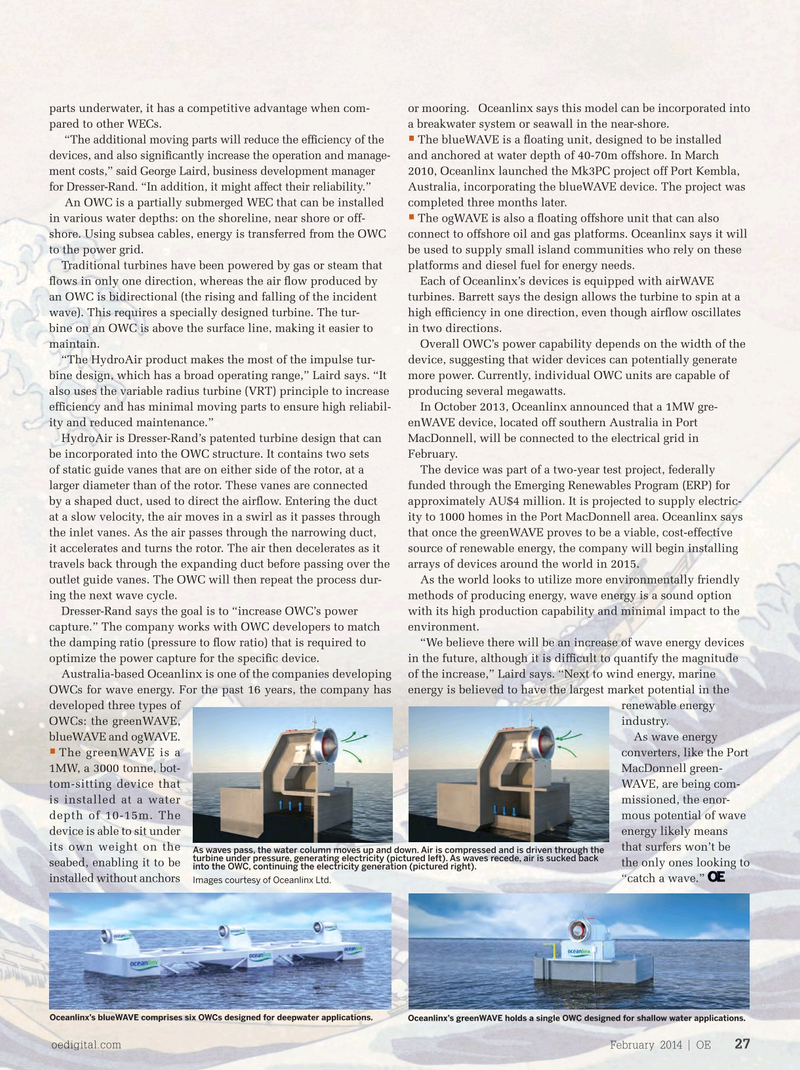
Page 25: of Offshore Engineer Magazine (Feb/Mar 2014)
Read this page in Pdf, Flash or Html5 edition of Feb/Mar 2014 Offshore Engineer Magazine
parts underwater, it has a competitive advantage when com- or mooring. Oceanlinx says this model can be incorporated into pared to other WECs. a breakwater system or seawall in the near-shore.
The blueWAVE is a ? oating unit, designed to be installed • “The additional moving parts will reduce the ef? ciency of the
Making and anchored at water depth of 40-70m offshore. In March devices, and also signi? cantly increase the operation and manage- 2010, Oceanlinx launched the Mk3PC project off Port Kembla, ment costs,” said George Laird, business development manager
Australia, incorporating the blueWAVE device. The project was for Dresser-Rand. “In addition, it might affect their reliability.” An OWC is a partially submerged WEC that can be installed completed three months later.
WAVES • in various water depths: on the shoreline, near shore or off- The ogWAVE is also a ? oating offshore unit that can also shore. Using subsea cables, energy is transferred from the OWC connect to offshore oil and gas platforms. Oceanlinx says it will to the power grid. be used to supply small island communities who rely on these
Traditional turbines have been powered by gas or steam that platforms and diesel fuel for energy needs. ? ows in only one direction, whereas the air ? ow produced by Each of Oceanlinx’s devices is equipped with airWAVE an OWC is bidirectional (the rising and falling of the incident turbines. Barrett says the design allows the turbine to spin at a wave). This requires a specially designed turbine. The tur- high ef? ciency in one direction, even though air? ow oscillates bine on an OWC is above the surface line, making it easier to in two directions. maintain. Overall OWC’s power capability depends on the width of the “The HydroAir product makes the most of the impulse tur- device, suggesting that wider devices can potentially generate bine design, which has a broad operating range,” Laird says. “It more power. Currently, individual OWC units are capable of also uses the variable radius turbine (VRT) principle to increase producing several megawatts. ef? ciency and has minimal moving parts to ensure high reliabil- In October 2013, Oceanlinx announced that a 1MW gre- ity and reduced maintenance.” enWAVE device, located off southern Australia in Port
HydroAir is Dresser-Rand’s patented turbine design that can MacDonnell, will be connected to the electrical grid in be incorporated into the OWC structure. It contains two sets February. of static guide vanes that are on either side of the rotor, at a The device was part of a two-year test project, federally larger diameter than of the rotor. These vanes are connected funded through the Emerging Renewables Program (ERP) for by a shaped duct, used to direct the air? ow. Entering the duct approximately AU$4 million. It is projected to supply electric- at a slow velocity, the air moves in a swirl as it passes through ity to 1000 homes in the Port MacDonnell area. Oceanlinx says the inlet vanes. As the air passes through the narrowing duct, that once the greenWAVE proves to be a viable, cost-effective it accelerates and turns the rotor. The air then decelerates as it source of renewable energy, the company will begin installing travels back through the expanding duct before passing over the arrays of devices around the world in 2015. outlet guide vanes. The OWC will then repeat the process dur- As the world looks to utilize more environmentally friendly ing the next wave cycle. methods of producing energy, wave energy is a sound option
Dresser-Rand says the goal is to “increase OWC’s power with its high production capability and minimal impact to the capture.” The company works with OWC developers to match environment. the damping ratio (pressure to ? ow ratio) that is required to “We believe there will be an increase of wave energy devices optimize the power capture for the speci? c device. in the future, although it is dif? cult to quantify the magnitude
Australia-based Oceanlinx is one of the companies developing of the increase,” Laird says. “Next to wind energy, marine
OWCs for wave energy. For the past 16 years, the company has energy is believed to have the largest market potential in the developed three types of renewable energy
OWCs: the greenWAVE, industry.
blueWAVE and ogWAVE. As wave energy • The greenWAVE is a converters, like the Port 1MW, a 3000 tonne, bot- MacDonnell green- tom-sitting device that WAVE, are being com- is installed at a water missioned, the enor- depth of 10-15m. The mous potential of wave device is able to sit under energy likely means its own weight on the that surfers won’t be
As waves pass, the water column moves up and down. Air is compressed and is driven through the turbine under pressure, generating electricity (pictured left). As waves recede, air is sucked back seabed, enabling it to be the only ones looking to into the OWC, continuing the electricity generation (pictured right). installed without anchors “catch a wave.”
Images courtesy of Oceanlinx Ltd.
Oceanlinx’s blueWAVE comprises six OWCs designed for deepwater applications. Oceanlinx’s greenWAVE holds a single OWC designed for shallow water applications.
Dresser-Rand’s Hydroair turbine integrated with an Oceanlinx unit. Images courtesy of Dresser-Rand.
oedigital.com February 2014 | OEoedigital.com February 2014 | OE 2727 000_OE0214_CoverStory2_Jernigan.indd 27 1/21/14 3:49 PM

 24
24

 26
26